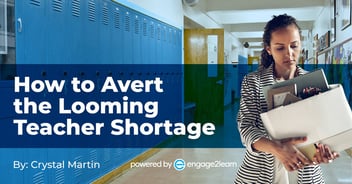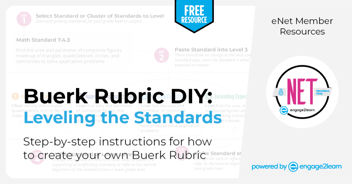The Next 90-Day Plan for Instructional Leaders | engage2learn
Focus on These 3 Goals
Public schools have done a miraculous job of reinventing school in the last few weeks. Now, the focus is turning to next year and how to plan for an uncertain 2020-21. As public school leaders are inclined to do, the conversation now is: how can we do better? As we have listened to our 47 current partners and many more friends in public education, there seem to be three main goals every school district has for next year:
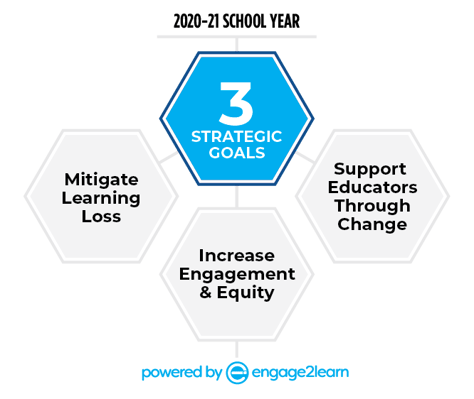
-
- Mitigate Learning Loss
- Increase Engagement and Equity
- Support Educators Through Change
Having served as an Assistant Superintendent for Teaching and Learning, I know what I would be thinking if I were working in a district under these conditions. So, I offer this 90-day plan as a possible starting place for how to potentially think about meeting these goals with elegant solutions. Of course, there is one key caveat we have to consider first.
Plan for 4 Futures, Not Just 1
In developing a strategic plan for a school district to meet these goals, it is important to think about all possible futures for 2020-21 and backwards design a strategy that will work regardless of the scenario. Our team recently took on the challenge of scenario planning 2020-21, and it became apparent that there are four possible scenarios that could happen across and/or within districts at any given time. Hopefully, thinking this way can move us all from “waiting to see” or “Plan A, B, C” type thinking to clear, consistent forward strategies.
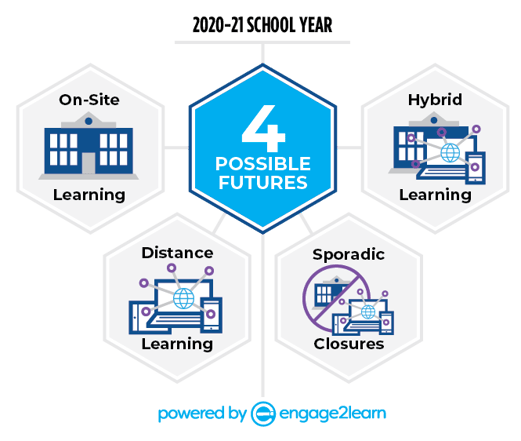
The strategies selected for this 90-day plan are those that will work in any combination of the following four future scenarios:
- On-site Learning: All schools are serving all students on-premises.
- Distance Learning: All schools are serving all students virtually.
- Sporadic Closures: Future flare-ups of the virus cause some schools to temporarily close, potentially while others remain open.
- Hybrid Learning: Schools are open, serving some students on-premises, while other more vulnerable populations are being served virtually.
The Next 90-Day Plan
So, here is the three-phase approach you can use to structure your next 90 days.
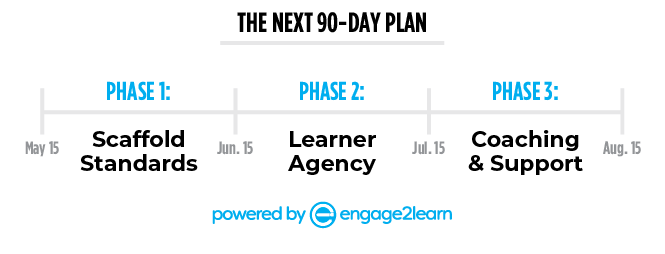
Phase 1: Mitigate Learning Loss by Scaffolding Standards
(May 15 – June 15)
Scaffolding is an effective tool to mitigate learning loss. Students are much more willing to learn new content when the ideas seem approachable and manageable. One of the primary benefits of scaffolding is that it simplifies complex ideas. Scaffolding gently eases students into unfamiliar ideas, preventing them from being overcome by learning anxiety.
A traditional teacher lecture followed by a worksheet does not set the stage for learning. There is no previewing of lesson specific vocabulary, no class discussion of prior knowledge of the lesson topic, and no expectations set. If a fourth-grade teacher in Texas writes the words “identify”, “compare” and “American Indian groups” on the board and asks students to explain what they know about those 3 words and ideas, she is scaffolding the fourth grade standard. The teacher can immediately see if students understand what it means to identify and compare in order to continue with the lesson.
Scaffolding allows the teacher and students to jointly explore unfamiliar words, determine what students already know about the topic, and discuss what they expect to learn and how it will be demonstrated. Students can see a clear beginning and the end goal. The learning becomes more interactive and cooperative as students learn from what they know, what peers provide, and teacher discussion.
In order to accelerate growth among students in 2020-21, (especially those most impacted by learning loss), you can use our free workspace, Scaffolding the Standards–and of course, all the great resources from Lead4ward–to scaffold the standards from the last nine (9) weeks of 2019-20 vertically into clusters within the 1st nine weeks of 2020-21. After scaffolding the standards, your next step here would be to level the standards and align resources to allow for true differentiation. Feel free to reach out to us if you feel like you or your teachers need help creating leveled, standards-aligned rubrics (Start Partnership).
For additional FREE resources for mitigating learning loss, please visit the 2020-21 Instructional Planning page.
Phase 2: Increase Engagement and Equity by creating Learner Agency (June 16 – July 15)
The learning process should include a variety of educational activities that students perceive as meaningful and interesting. When students have a choice, they take on the role of agent in their learning and the teacher serves as the facilitator and coach. Learner agency has sometimes been referred to as inquiry-based learning or project-based learning because students choose a topic or question to present within the framework of the lesson. They then decide how to demonstrate their mastery of the lesson guidelines.
The idea of this strategy (which has given our 47 partner districts a huge head start this spring) is to have an organizing structure that is accessible to teachers, students, and parents that moves from teacher-driven to student-driven learning. Because let’s face it: distance learning doesn’t work if it is solely teacher-directed. Learners stay engaged when they have a clear process and tools to own the learning, set goals, make choices, and track their growth. By putting the learning in the hands of the learners with a coach teacher–instead of relying on parents/families–we have seen learners from every demographic engaged and flourishing. Our team is publishing two of our proven learner-driven growth tracking processes within the next week on our Virtual Learning Resource page free to everyone.
For additional FREE resources for increasing learner agency, please visit the 2020-21 Instructional Planning page.
Phase 3: Create a System to Support Educators through Change (July 16 – August 15)
Educators need ongoing, job-embedded support during this time MORE THAN EVER, and the best way to support them is by providing ongoing coaching for educators and creating Virtual Professional Learning (VPL) teams. Scheduling at least seven personalized coaching sessions with each teacher, campus leader, and coach teacher over the first seven months of 2020-21 will ensure that educators have the support to face any change and make adjustments along the way. The frequency of a coaching session every few weeks has proven effective over the last nine years in our practice and this spring during virtual coaching with our partner districts.
Furthermore, creating VPL teams has also been an effective tool for supporting direct teacher coaching. By coaching educational leadership, the expertise of an assistant principal, technology or instructional coach, and library/media specialist provides blended support for teachers as well. To see other ideas that have been working this spring to support educators through change, visit our Virtual Learning Resource page or attend our free two-day Redesign PD Unconference.
For additional FREE resources for supporting educators, please visit the 2020-21 Instructional Planning page.
Mentorship and collaboration play a crucial role in supporting educators through change. Experienced teachers can serve as mentors, providing guidance, coaching teachers, sharing best practices, and offering a listening ear. By fostering a collaborative culture within educational institutions, educators can engage in peer-to-peer learning, problem-solving, and idea exchange. This creates a supportive community where educators can learn from one another, gain fresh perspectives, and feel empowered to navigate change.
Educators play a vital role in shaping the future of society and supporting them with instructional coaching through change is crucial for educational institutions and communities. By focusing on these three strategies over the next 90 days, your teachers and students will be ready to hit the ground running come August, no matter what that ground may look like.

